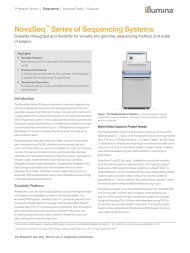Abstracts
ngsfinalprogram
ngsfinalprogram
You also want an ePaper? Increase the reach of your titles
YUMPU automatically turns print PDFs into web optimized ePapers that Google loves.
Poster <strong>Abstracts</strong><br />
tive comparator for contextualizing isolates<br />
regardless of the molecular typing method<br />
used. Two isolates occurred in clades with<br />
bootstraps of 65 and 100%, which otherwise<br />
contained single PCR RTs. Repeat sequencing<br />
and PCR ribotyping of these two isolates confirmed<br />
the unusual placement of a single RT<br />
014 isolate within the RT 020 clade, and vice<br />
versa. Fluoroquinolone resistance determinants<br />
were common (82%) among the hypervirulent<br />
epidemic RT 027 genomes; only one non-027<br />
isolate (RT 017) harbored a Thr82Ile mutation<br />
in GyrA, which confers fluoroquinolone resistance<br />
in other species. These molecular and<br />
epidemiological data will be publicly available<br />
through NCBI, and isolates have been deposited<br />
for distribution with BEI Resources.<br />
n 65<br />
IMPLEMENTATION OF WHOLE GENOME<br />
SEQUENCING (WGS) FOR SURVEILLANCE<br />
AND OUTBREAK DETECTION OF SHIGA<br />
TOXIN-PRODUCING ESCHERICHIA COLI<br />
(STEC) IN THE UNITED STATES<br />
R. L. Lindsey 1 , H. Carleton 1 , K. Joensen 2 , F.<br />
Scheutz 3 , L. Garcia-Toledo 1 , D. Stripling 1 , H.<br />
Martin 1 , N. Strockbine 1 , L. S. Katz 1 , L. Gladney<br />
1 , T. Griswold 1 , S. Im 1 , E. M. Ribot 1 , E.<br />
Trees 1 , H. Pouseele 4 , P. Gerner-Smidt 1 ;<br />
1<br />
Centers for Disease Control and Prevention,<br />
Atlanta, GA, 2 Technical University of Denmark,<br />
Lyngby, DENMARK, 3 Statens Serum<br />
Institut, Copenhagen, DENMARK, 4 Applied<br />
Maths, Sint-Martens-Latem, BELGIUM.<br />
Introduction: Shiga toxin-producing Escherichia<br />
coli (STEC) is an important foodborne<br />
pathogen capable of causing severe disease in<br />
humans. Current methods for characterization<br />
of STEC are expensive and time-consuming.<br />
Work has begun to replace traditional methods<br />
with those using whole genome sequence<br />
(WGS) data by developing an allele database<br />
of individual Escherichia genes in BioNumerics<br />
7.5, (Applied Maths, Austin, TX). This<br />
will allow characterization of Escherichia<br />
in a single workflow using a multi-locus sequence<br />
typing (MLST) approach. Materials<br />
and Methods: The Escherichia allele database<br />
was built with 314 annotated reference<br />
genomes from a geographically diverse collection<br />
of human, animal and environmental<br />
strains as well as genes encoding virulence<br />
factors, antimicrobial resistance and O and<br />
H antigens from databases at the Center for<br />
Genomic Epidemiology (DTU, Lyngby, Denmark).<br />
The reference genomes represent 50<br />
E. coli serogroups, four Shigella species and<br />
four additional Escherichia species. Multiple<br />
subschema will be built within the database<br />
to perform identification, characterization and<br />
subtyping, including classical, extended, core<br />
and whole genome MLST. To test the ability of<br />
the BioNumerics-based whole genome MLST<br />
approach to correctly identify, characterize and<br />
cluster strains, we analyzed 500 Escherichia<br />
isolates from sporadic and outbreak-related<br />
infections and compared the findings to those<br />
obtained previously with phenotypic and<br />
molecular subtyping methods. Results and<br />
Discussion: The Escherichia allele database<br />
contains 18,883 loci. For the 500 Escherichia<br />
isolates analyzed, there was 95% concordance<br />
in the results generated by the traditional and<br />
wgMLST approaches. Conclusions: The<br />
BioNumerics-based wgMLST approach provides<br />
a single, cost effective strategy to identify<br />
and characterize isolates for surveillance<br />
and outbreak investigations. The analysis tools<br />
in BioNumerics will enable end-users in public<br />
health laboratories to analyze WGS data they<br />
generate with little bioinformatics expertise,<br />
making the system equally efficient for local<br />
and central investigations. The system will be<br />
refined through continued collaboration with<br />
domestic and international partners.<br />
ASM Conference on Rapid Next-Generation Sequencing and Bioinformatic<br />
Pipelines for Enhanced Molecular Epidemiologic Investigation of Pathogens<br />
83



